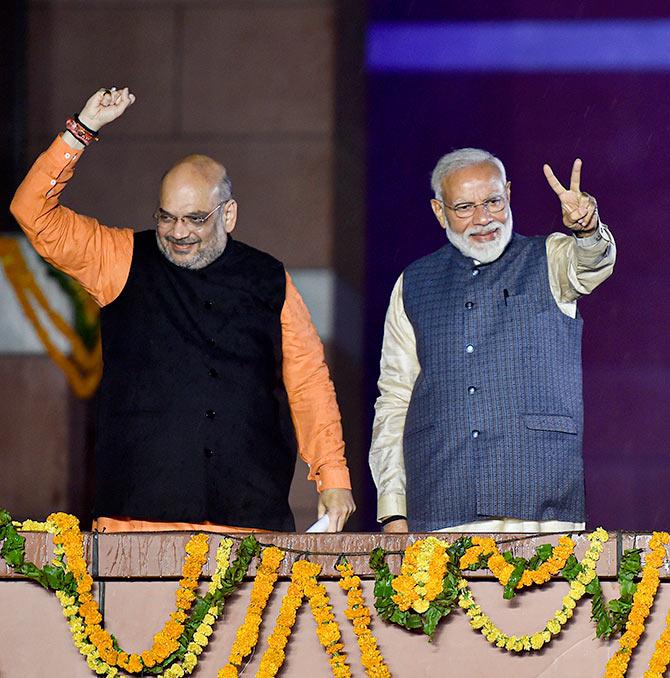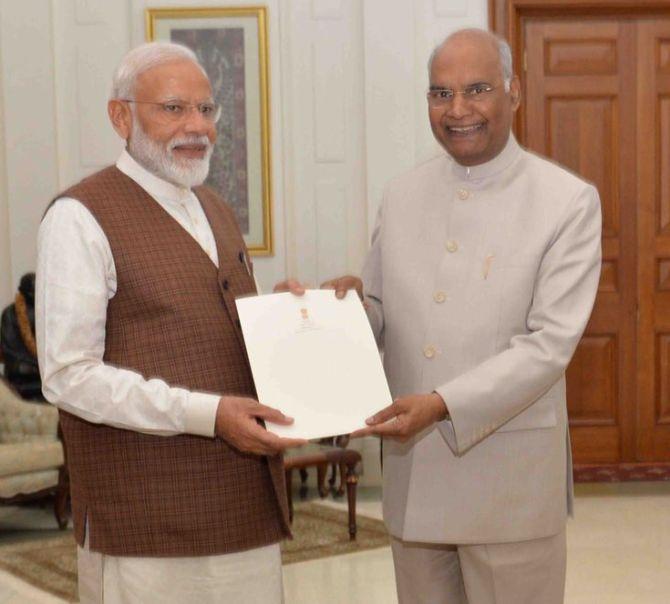 | « Back to article | Print this article |
Modi and Shah's next focus will be South India, and the Maharashtra and Jharkhand assembly elections.
Shah is unlikely to abdicate control over the party even after he joins the government.
Modi and Shah both know only too well that the party makes the government, and not the other way round.

There is no debate whatsoever about who should get maximum credit for the Election 2019 Verdict.
Narendra Damodardas Modi. Right?
If you agree, then please remember September 17, 2025.
This date will be the turning point for India and Modi. He turns 75 on that day. He will, most likely, retire on that day.
It is most unlikely that he will remain in power for one day more.
He has set the tradition for Bharatiya Janata Party leaders to retire at 75. He is likely to obey his own diktat.
In other words, he arrives at his second term in prime ministerial office with a shelf life of around 1,826 days -- if he successfully completes it, which is likely.
If he wins a third consecutive term, then he has on hand around 2,300 days in which he has to build the India of his dreams.
During his election campaign, while asking voters for a second term, Modi repeatedly said, 'Abhi to Congress ke chode hue khadde bhare hai, Imarat banana baki hai.' (Loosely translated, it means 'I was clearing the Congress created mess, I will build a new India in the second term.')
In his second term Modi will be a man in a hurry. He will be in the fast lane of governance and politics as he doesn't have much time left for his ideas of 'nation building'.
He has with him July 2019 to September 2025, even if he wins a third term.
Ask then prime minister Dr Manmohan Singh how swiftly the ten years between 2004 and 2014 flew away.

In India where lakhs of school rooms, lakhs of hospital beds, crores of toilets, thousands of kilometres of pipelines for drinking water and digital connections and hundreds other things are yet to be provided to the people and where even Rs 50 lakh crores are not enough to build roads in cities and villages and homes for some 200 million plus families, Modi and Bharatiya Janata Party President Amit Anilchandra Shah are acutely aware that to administer and run a country of 1.3 billion people with limited resources, money and technology is a miracle and to create new assets in just seven years alongside governing a quite ungovernable country remains the planet's most difficult task.
Modi and Shah will work like men possessed to achieve this result, but political actions will not take a back seat.
The government and party will sculpt such an image of Modi that it won't be surprising if his bhakts start calling him Sant Modi by 2024.
By the end of this second term in office, Modi hopes to transcend his image beyond politics and appeal to Cultural India.

No less important in the unfolding events is the making of the Modi-Shah jugalbandi.
In the last five years Modi and Shah have avoided appearing frequently on common platforms and even speaking in measured tones about each other in public. But the 2019 victory appears to have elevated Shah to a different plane.
Modi appears to be making up his mind about helping Shah build the foundation stone of his national career on Raisina Hill in the coming decades.
In the last five years, the media -- soft or critical of the government -- has been unable to report a well-informed story explaining the Modi- Shah dynamic. The internal functioning of their relationship has been the best kept secret of the last five years.
Both men have been working together for many years, but very few know how the tremendous power of Delhi has influenced their internal dynamic. Both men have completely eliminated intermediaries between them.
Every day, more than once, Modi and Shah speak to each other, keep each other informed, keep each other in the loop about the political games they play. This has made it difficult for anyone to play on the ego of either of them to get things done.
Certainly, their synergy and unfailing coordination is the untold story of Modi's first term. How the lakshman rekha between the government and the party has blurred, how Modi and Shah have made electoral politics the vehicle to achieve their goals will upset the Opposition.
Their synchronised political movements have contributed to the success of both, the party and government.
Until 2019, Amit Shah was Modi's deputy. After the 2019 triumph, Shah is Modi's supplementary force.
Shah is trying harder than anyone to expand the Rashtriya Swayamsevak Sangh's appeal and his party's permanent structures. He has understood and absorbed the politics of -- ironically -- Indira Gandhi. Many BJP-RSS leaders revere Indira Gandhi as they believe she was a staunch Hindu and a genuine nationalist. Many observers find elements of Indira Gandhi in Modi's decisions.
Shah, like Modi, has also worked hard to understand how the legend of Ram Manohar Lohia was created, how Kanshi Ram created the Bahujan Samaj Party.
Since 1952, the Jan Sangh -- the BJP's political parent -- and later BJP leaders never understood that a radical election campaign, which could unite Hindus, can bring sizable Hindu votes to the BJP and limit the sway of Muslim-supported parties in UP.
This one political assertion -- of taking collective Muslim voting power head on -- has brought the Modi-Shah combine twice to power.
Modi-Shah's politics in Uttar Pradesh signifies that BJP leaders like Lal Kishenchand Advani were wary about asserting a Hindu identity and letting Muslim-backed parties like the Samajwadi Party know that its potent minority card was unacceptable in a nation with a Hindu majority.
This one reason is why the BJP has emerged as the strongest ever in its history.
In the election battleground of UP, parties like the SP, BSP and Congress were unable to brandish the Muslim card because it was made a liability by Modi's campaign style.
As soon as Muslims aligned with the SP, BSP and Congress, the BJP portrayed Hindus as victims and garnered votes.

Modi and Shah plan to expand the BJP's frontiers with the help of their three decade-long study of the caste metrics in Indian politics. Both men have studied caste leaders who flourished in India after Jawaharlal Nehru.
Modi and Shah's next focus will be South India, and the Maharashtra and Jharkhand assembly elections.
Shah is unlikely to abdicate control over the party even after he joins the government.
Modi and Shah both know only too well that the party makes the government, and not the other way round.
In the coming five years, the Jammu and Kashmir issue will see a decisive turn, with a break from the status quo. To achieve this, Modi will keep global powers in the loop.
Modi's success in this round of the democratic process is so enormous that it will take time to count how many forces, people and issues have fallen by the wayside or been demolished completely.

In 2014, what was true of the Modi government and the BJP is and will be true in the years to come.
There will never be a compromise on nationalism.
There will be no compromise on allowing Muslims to exert disproportionate strategic power to change the fate of electoral results in any constituency.
There will be efforts to exploit the next phase of the goods and service tax.
Giving housing to the poor will be one of the Modi government's top-most priorities in the coming three years.
Notwithstanding their communal politics, the nation will seek an answer to promises made and both Modi and Shah are acutely aware of it.
Hindutva and development can go together is their favourite line. Now Narendra Damodardas Modi and Amit Anilchandra Shah will need to prove it.